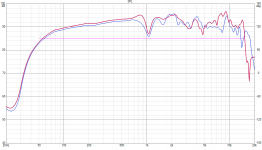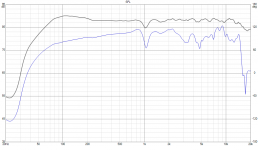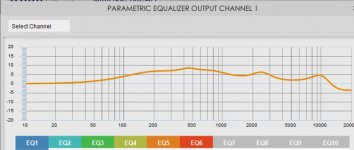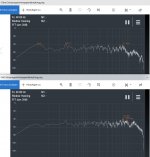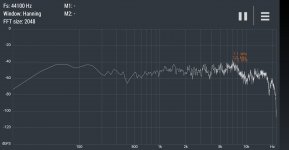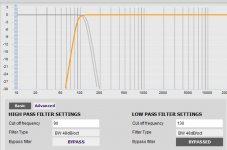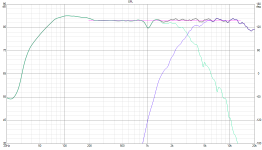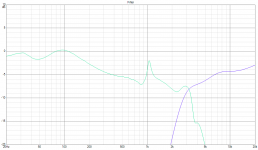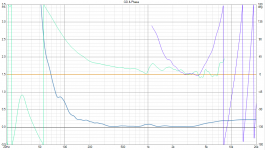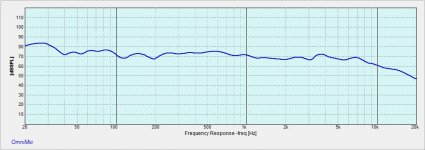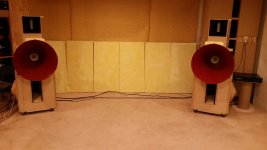I use the 1772 above 250Hz, and front-horn load it, to boot. The horn *lifts* the otherwise anemic lower mid-range level. In this manner, the sound quality is SUPERB,and will only be bested by spending multiples of times more money. I also should mention that after ears and years of enjoying the sound, albeit with a slight "recessed" upper mid-range, I now use a single-ended, class A,
5 watt amp. This has transformed an excellent sound quality into one I would have to rate as sublimep.s. I do use a ribbon tweeter above 8kHz.
Would the distance between the full range and the tweeter be enormous with front horn?
You are one lucky man... I was curious myself.
The responses are far more alike than the measurements by Rutcho... and pretty much what you already expected? So you can see a small hickup probably due to the different voice coil diameter, and a touch less treble (Le).
Find attached the responses from VCAD... 1772 first. Take the response below 300Hz with a grain of salt... kind of manipulated by myself to reflect the response in a 'normal' cabinet (i.e. baffle diffraction).
Thanks, that's really interesting. So both have peaks around 3Khz and 8Khz, and that 3Khz peak looks relatively easy to correct with a notch.
The flatness of your 1772 measurement through the 1Khz region is especially impressive and unexpected - it's almost inevitable for an 8" driver to have a dip here due to "surround dip" of a ~16cm cone so to see one without this typical dip is quite unusual.
Interesting that the 1808 does show a typical slight peak then dip around 1Khz - can you see any visible differences in the surrounds between the two models ? Material ? Damping additive ? Radius of the reverse roll ?
My two Coral drivers are hand assembled ones, and as a result they have small mechanical differences in assembly that unfortunately make quite big differences in frequency response.
In the attached image the red one is the right driver and blue the left driver measured under the same conditions on a 39cm x 62cm box. >300Hz is gated and <300Hz is a spliced nearfield measurement with 1/2 space transition simulated. (In other words how it should measure at a distance, with no network)
An interesting difference between the two is that the red one has a peak at 800Hz before the dip similar to your 1808 measurement, but the blue one does not have the peak, only a dip.
One of the differences between the two drivers is that the reverse roll fabric surrounds are different - the red one has a wide radius curve that takes up most of the gap between the surround and frame while the blue one has a smaller radius curve and then a significant flat section of fabric on either side of the roll before it meets the cone and frame. This difference in curvature seems to be responsible for the differences around 1Khz...
Differences at higher frequencies around 2-5Khz are due to the Z axis alignment of the whizzer cones being different by a couple of mm (hand assembled...) while the treble differences are due to both drivers having the aluminimum domes pushed in by my then 3 year old, but pushed in different amounts!!
In other words they're a bit worse for wear now...
Anyway that 1772 measurement looks quite promising to me for what I have in mind...
Attachments
Last edited:
So both have peaks around 3Khz and 8Khz, and that 3Khz peak looks relatively easy to correct with a notch.
Yes, they have almost identical peaks at 3Khz, as do a LOT of whizzer cone fullrange drivers. Easy to notch out.
Both curves were taken in 2011 with MLSSA, originally in an infinite baffle (measurement set up is that they have a huge cabinet in the floor of their test room and mount the drivers with custom baffles into that cabinet that extends into the room floor, microphone comes from above @1m).
Both drivers show an irregularity in the impedance curve @1 Khz that doesn't result in a dip in the FR response... it's actually more like a pimple in the curve, more so on the 1808. Maybe I did the tracing a bit to hastily... the 1808 has no extreme dip, especially not like like a few others (Fast 8, Fostex). When you mount them into a cabinet with a certain baffle width you can 'tailor' the baffle step to match the response. That is what I tried with my 'manipulating'. But I would cross them (1772 would be my choice) @250Hz-ish anyway to retain the sensitivity in the midrange and up.
According to the magazine the 1772 has a coated cloth surround while the 1808 sports one made from rubber. Aaah!
Interesting that Coral did so well so long ago and that there is no driver on the market that betters them considerable. And I don't trust the boutique drivers.
Certainly easier to notch out that peak at 3Khz in a passive network than trying to boost a dip in the response..Yes, they have almost identical peaks at 3Khz, as do a LOT of whizzer cone fullrange drivers. Easy to notch out.
Sounds like a lot of care was taken in those measurements.Both curves were taken in 2011 with MLSSA, originally in an infinite baffle (measurement set up is that they have a huge cabinet in the floor of their test room and mount the drivers with custom baffles into that cabinet that extends into the room floor, microphone comes from above @1m).
Interesting that the impedance bump is there on both drivers but only one manifests a frequency response dip...Both drivers show an irregularity in the impedance curve @1 Khz that doesn't result in a dip in the FR response... it's actually more like a pimple in the curve, more so on the 1808. Maybe I did the tracing a bit to hastily... the 1808 has no extreme dip, especially not like like a few others (Fast 8, Fostex).
My plan is to roll the 1772 off below about 250Hz as well. (to cross with a 12" woofer) With a 2nd order mechanical roll off from a small closed box (approx 12 litres) combined with a 2nd order electrical filter to give an accoustic 4th order linkwitz reily at 250Hz in the far field.When you mount them into a cabinet with a certain baffle width you can 'tailor' the baffle step to match the response. That is what I tried with my 'manipulating'. But I would cross them (1772 would be my choice) @250Hz-ish anyway to retain the sensitivity in the midrange and up.
A little bit of playing about in Vituixcad's box simulator, baffle diffraction simulator and crossover simulator suggests that I can get pretty close to an ideal 4th order L/R accoustic reponse just with the right size closed box (somewhere around 10-15 litres) and a simple LC high pass filter, thanks to the very low Qes of the driver. The 1808 on the other hand would have a major peak at cutoff in such a small enclosure due to the higher Q and wouldn't be manageable with a passive crossover.
Aah Indeed.According to the magazine the 1772 has a coated cloth surround while the 1808 sports one made from rubber. Aaah!
However doped cloth is superior for damping of standing waves at the edge compared to either rubber or foam and is still relatively flexible for bass. (Albeit not very linear for high excursions...)
The interesting thing is I've owned three different sets of Coral drivers over the years - all have used reverse roll cloth surrounds, however the amount of doping has varied greatly.
The original factory assembled (early 70's) ones I owned had doped surrounds where there was some kind of damping substance (no idea what!) soaked into the surround. These were very flat through 1Khz with a very minimal dip. However with age that doping material seems to go hard and make the surround a bit stiff causing a big loss of bass response and excursion ability. (To be fair we're talking about 30-40 years age...)
The ones I have now which were hand assembled by someone in the early 2000's from NOS parts have no doping in the cloth surrounds at all, they're just plain cloth, and as a result they are very flexible and bass performance is excellent, however they have much bigger dips at 1Khz than the older ones I had.
I could in theory add the missing doping and flatten out the response at 1Khz considerably but I'm terrified of attempting something like that on drivers I can't replace as (a) I have no idea what the original doping is (b) I don't want it to stiffen with age as the factory doping sometimes did and (c) I can't undo it if it stuffs up the response... so I choose to work around it a bit in the network in a non-invasive way instead.
I'm pleased to hear that the 1772 has doped cloth surrounds, and that is one more reason for me to choose the 1772 instead of the 1808. While the 1808 might be better for bass in a BR enclosure, if I'm not using them for bass the 1772 is the clear winner with cloth surounds and a smoother midrange.
Some of the vintage Coral drivers were really ahead of their time. The Beta series gets quite a bit of recognition but to be honest the "Flat" series measure a lot better (flatterInteresting that Coral did so well so long ago and that there is no driver on the market that betters them considerable. And I don't trust the boutique drivers.
(The lower line in the graph below is the same raw response of one of the Coral drivers as in my previous post, the upper line is the system response of the Coral driver plus ribbon tweeter - it's almost hard to believe that such a flat response is possible from that starting point... it's amazing what a bit of effort with even a passive crossover can achieve
Part of their success seems to be the curvilinear whizzer cones that don't seem to suffer from the same severe 2-3Khz resonanaces that a regular conical whizzer cone experiences, also the stamped rings around the outside of the main cone (which I call "decoupling rings") seem to help a lot with cone breakup around 2-5Khz. The curvilinear whizzer cone of the W8-1772 which is very similar in size and shape to the Coral ones is one of the things that attracts me to it.
I've looked for a long time to try to find a modern driver that is the same size and basic design and performs as well and tried a few like the Fostex FE207 along the way (was very disapointed by them, they don't even come close) but from everything I can see from measurements, studying their design and reading opinions of those who have used them, the W8-1772 probably if anything out perform the Coral drivers.
The only problem is trying to get hold of a pair in the UK - importing from the US (parts express etc) it's likely to see me charged a large customs fee, while EU/UK sellers either have very high prices or say "out of stock".
They are still being made are they ? Or have they paused manufacturing during coronavirus ?
Attachments
Last edited:
I am using in my kitchen some Lii Audio Fast 8 in some kind of open baffles: IKEA Nypon pots, mounted on a lamp stand.
It's an 2.1 system, a FAST. Driven over a MiniDSP and an F5 amplifier, the subwoofer driven by a T-amp.
Lets try to upload some pictures
It's an 2.1 system, a FAST. Driven over a MiniDSP and an F5 amplifier, the subwoofer driven by a T-amp.
Lets try to upload some pictures
Attachments
-
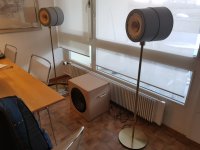 20200112 Lii Audio Fast 8 in Nypon Baffle Gesamtansicht.jpg445.7 KB · Views: 261
20200112 Lii Audio Fast 8 in Nypon Baffle Gesamtansicht.jpg445.7 KB · Views: 261 -
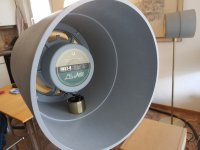 20200112 Lii Audio Fast 8 in Nypon Baffle 1.jpg387.1 KB · Views: 254
20200112 Lii Audio Fast 8 in Nypon Baffle 1.jpg387.1 KB · Views: 254 -
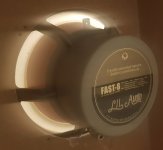 20191220_173046.jpg425 KB · Views: 244
20191220_173046.jpg425 KB · Views: 244 -
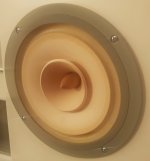 20191220_173023.jpg446.3 KB · Views: 116
20191220_173023.jpg446.3 KB · Views: 116 -
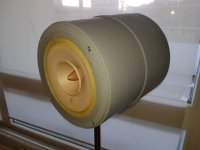 20200112 Lii Audio Fast 8 in Nypon Baffle.jpg444.8 KB · Views: 133
20200112 Lii Audio Fast 8 in Nypon Baffle.jpg444.8 KB · Views: 133 -
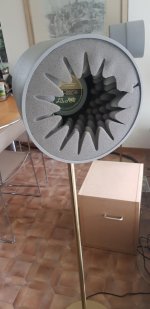 Dämpfung.jpg254.3 KB · Views: 128
Dämpfung.jpg254.3 KB · Views: 128
Here my simple measurements with my mobile phone. Before (upper half) and after installing the foam on the backside (lower half of the picture).
I show also the eq settings I was using during this "measurement"
I show also the eq settings I was using during this "measurement"
Attachments
I just made a measurement with the DSP EQ set to "flat" (including the foam in the backside of the pot)
Below 90 Hz you see the subwoofer and not the Lii Audio Fast 8
Below 90 Hz you see the subwoofer and not the Lii Audio Fast 8
Attachments
Last edited:
As for dips in the frequency response I am more concerned about peaks than dips... yes it is difficult to 'fill' a dip,especially with a passive crossover, but a gentle dip at around 1Khz wouldn't bother me that much as a peak at 3Khz where my hearing is the most sensitive.
Any dip in the 1 Khz region will also be affected by the boost in level from the baffle step, I've seen measurements in Hobby Hifi where the dip all but disappeared when mounted in a cabinet (TB W2145). So would I ever build a new fullrange speaker with a W8-1772 or other I would of course first do the measuring in the planned cabinet. Would have to revive the old CLIO system that still runs on my very first computer (--> ISA card )
)
Seems they are available in Germany... how much taxes do you have to pay when buying in Germany for instance?
Lautsprecher Shop | Breitband Tang Band W8-1772 | Lautsprecher Selbstbau
TangBand-Lautsprecher W8-1772
Any dip in the 1 Khz region will also be affected by the boost in level from the baffle step, I've seen measurements in Hobby Hifi where the dip all but disappeared when mounted in a cabinet (TB W2145). So would I ever build a new fullrange speaker with a W8-1772 or other I would of course first do the measuring in the planned cabinet. Would have to revive the old CLIO system that still runs on my very first computer (--> ISA card
Interesting... absolutely my plan. Put the 1772 in an enclosure of max. 35cm width with the 12" woofer in the side. That is how I would do it. Even with a 12" it is not easy to find one that will reach around 90 dB when crossed at 200Hz, I liked the Beyma SM-112 because of its low losses.My plan is to roll the 1772 off below about 250Hz as well. (to cross with a 12" woofer)
The only problem is trying to get hold of a pair in the UK
Seems they are available in Germany... how much taxes do you have to pay when buying in Germany for instance?
Lautsprecher Shop | Breitband Tang Band W8-1772 | Lautsprecher Selbstbau
TangBand-Lautsprecher W8-1772
Franz,
I don't quite understand your EQ settings that you are showing... usually you have to tame some peaks in the midrange and the treble. How did you arrive at the response of your Fast 8's?
Now it's me not understandig your question.
The eq settings I am using are leading to the response I measured. Thats it!
/Edit
Overall, I don't tame peaks, but I correct broader tendencies with low Q settings of the filters.
Last edited:
Sure, a dip at 1Khz is fairly innocuous - even after partial correction in the network I still have about a 3dB dip at 1Khz, personally I can't really notice it - as an experiment I've tried using active EQ to completely remove it and while I can hear a difference it's minor and I can't say that I prefer one over the other, and as it's not feasible to fix with a passive crossover I've just left it partially corrected...As for dips in the frequency response I am more concerned about peaks than dips... yes it is difficult to 'fill' a dip,especially with a passive crossover, but a gentle dip at around 1Khz wouldn't bother me that much as a peak at 3Khz where my hearing is the most sensitive.
Although it's a bit naughty, a small 1Khz dip can actually artificially enhance directional cues - HRTF for directly forwards has less energy at 1Khz than directly behind us, so a slight dip at 1Khz reinforces the phantom centre image as coming from directly in front of us instead of behind.
On the other hand a peak at 1Khz would be bad as that would be a "behind us" cue that would conflict with other cues causing ambiguous localisation.
A dip in the 2-4Khz region on the other hand sucks the life right out of a speaker. I've been very careful to get the balance from 2-4Khz just right and I did end up tweaking that slightly from the original design to "voice" the speaker. (I increased it about 0.2dB from flat...)
Absolutely. Infinite baffle measurements are important to compare different drivers fairly and consistently and find their response independent of any baffle/cabinet, (which has as much affect on the response as the driver itself) which is why I was trying to find such measurements for the 1772/1808.Any dip in the 1 Khz region will also be affected by the boost in level from the baffle step, I've seen measurements in Hobby Hifi where the dip all but disappeared when mounted in a cabinet (TB W2145). So would I ever build a new fullrange speaker with a W8-1772 or other I would of course first do the measuring in the planned cabinet. Would have to revive the old CLIO system that still runs on my very first computer (--> ISA card)
But once a driver is chosen and a cabinet designed the measurements used for equalisation/crossover design should always be "in cabinet" measurements taken in the final cabinet design - the Coral measurement I posted earlier is an in cabinet measurement of the final cabinet (a very basic 62cm x 39cm shoebox) and some of the peaks and dips in the 500Hz-3Khz region are no doubt a result of the cabinet, but have to be considered in the equalisation.
I took my final woofer and tweeter measurements (accoustic and impedance) using ARTA and imported them into Vituixcad (I started with Version 1 but migrated to V2 part way through the project when it came out) and designed the crossovers based on those in box measurements.
The end result was surprisingly close to optimal on first spin and I've only made small tweaks to the response since then - the main one was tweaking the BSC a bit as there was a little bit of uncertainty in my nearfield/farfield splicing. I ended up with a lower rollover point (larger coil) than original anticipated, perhaps because I have the speakers only half a metre from the front wall.
The 12" woofers I have are the Visaton W300 S - 8 Ohm, I actually bought them way back around 2003 and have used them in temporary cabinets for several years then put them back into storage for many years as I moved country. Sadly they are no longer made. Luckily I still have my original pair plus one spare I fortuitously bought at the time.Interesting... absolutely my plan. Put the 1772 in an enclosure of max. 35cm width with the 12" woofer in the side. That is how I would do it. Even with a 12" it is not easy to find one that will reach around 90 dB when crossed at 200Hz, I liked the Beyma SM-112 because of its low losses.
They have a 92dB/W/m sensitivity, are smooth all the way up to 1.5Khz, and have a fairly decent Xmax and Xsus for a driver with that sensitivity and smooth midrange. Their Xsus is quite a bit greater than Xmax which helps to make them fairly indestructable - I pushed them really hard for years and never had a peep of complaint out of them.
Even in an actively EQ'ed closed box they were very punchy down to about 30Hz - I crossed them over at 300Hz without any problems or needing any high frequency notches.
Plan is to put them in a BR box approx 110 litres tuned to 25Hz (which should vastly outperform their original active EQ closed box configuration) and cross them over at 250Hz to the 1772, then cross the 1772 over to a ribbon tweeter at about 4Khz. This is similar to a configuration I had the Coral drivers in once (using them basically as a wide range, high sensitivity midrange driver) and it worked very, very well.
Thanks, I'll check that out. The UK has of course left the EU now although I think for the purposes of buying things we're still effectively in the single market until the end of this year, so now might be a good time to buy!Seems they are available in Germany... how much taxes do you have to pay when buying in Germany for instance?
Lautsprecher Shop | Breitband Tang Band W8-1772 | Lautsprecher Selbstbau
TangBand-Lautsprecher W8-1772
The other thing I'm looking for is a new pair of Aurum Cantus G2. The original round face plate versions I have in this system aren't available any more but they still make it in a rectangular face plate.
Last edited:
They're crossed at 3Khz, 4th order L/R.Simon,
would you disclose how you arrived at that almost perfectly flat response with just a passive crossover? Or did you cross all the nonlinear part of the Coral away and ran the ribbon from 2Khz?
For many years I had them crossed at 4Khz, but as you can see from the raw measurement they have a significant dip at 3Khz, and coincidentally the ribbon tweeter has a small dip at 3Khz as well, so I wasn't able to remove the 3Khz dip with a passive crossover at 4Khz.
So I decided a little reluctantly to reduce the crossover point to 3Khz, which allowed me to retune the shape of the high and low pass sections to correct the dips in both drivers responses.
My hope is that with the 1772's response I will be able to move the crossover point back up to 4Khz as 3Khz is pushing the ribbon tweeter a little bit at high SPL. While they do work quite well down to 3Khz, the Aurum Cantus G2 are most happy with a 4Khz crossover point.
The crossover is pretty complicated and to be honest it was an exercise in "how far can you go" to correct the response of a driver passively. So in the end it has baffle step correction of about 6dB, a notch at 845Hz, a peak at 1.1Khz, a notch at 2.2Khz, and another one at 3.8Khz. The 3Khz 4th order low pass filter has then been "bent" considerably to bring the accoustic reponse almost exactly to a 4th order Linkwitz Reily.
You can see the contortions in the filter response in the image below.
How do they sound ? To my ear they sound extremely smooth and unfatiguing while still having good presence and imaging. I'm very happy with the result so while the crossover is rather complex the end result was worth it I think. It was also a fun exercise to see just how far it was possible to go in a passive crossover.
Attachments
Thank you very much for linking to this... I've just gone ahead and bit the bullet and ordered a pair of W8-1772 from them.Seems they are available in Germany... how much taxes do you have to pay when buying in Germany for instance?
TangBand-Lautsprecher W8-1772
£475 inc VAT and shipping for a pair is not too bad I think. No extra taxes (just normal VAT) and a very reasonable shipping price given their weight.
I've been teetering on the edge of ordering a pair for a few years now (my first post in this thread was 2010!) but other things have always got in the way, like house renovations and finishing up the speakers I already have, but time to get a pair and start on my next design using them now the Coral 2 ways are done...
Last edited:
Got it! Thank you. Is the slight drop off above 10Khz intentional or typical for the Fast 8? Or is it a limitation in your measuring set up?The eq settings I am using are leading to the response I measured.
It was also a fun exercise to see just how far it was possible to go in a passive crossover.
Your results are indeed quite impressing! Could your next purchase be a Mini DSP? Ok, just joking...
Did you ever listen to your Corals fullrange and such could compare the imaging/spatial qualities of them compared to the current two way solution?
Pretty much the only thing that has me going for a fullrange driver (hypothetically) is them being a point source and having no crossover in the midrange that 'could' have an effect on the imaging.
Years ago I was running open baffles with Saba or TFK 8" widebands and the ubiquitous SABA tweeters (and augmented by a closed active subwoofer) that sounded very convincing and had a very open and threedimensional stage.
I am still sure they could be bettered considerably.
Great! Strassacker is one of the biggest shops in Germany though I have never ordered from them. But then I am mostly building amplifiers lately.Thank you very much for linking to this... I've just gone ahead and bit the bullet and ordered a pair of W8-1772 from them.
Do post here for all your updates to come in the next... years?
I like the idea of active crossovers/EQ for testing/development/rapid prototyping, but when it comes to the finished design I think there is just something pure and timeless about having an entirely passive box with two terminals which you can connect any amplifier to and have it be this standalone thing with just the right crossover and frequency compensation built in. A black box that just works right. Maybe that view is old fashioned these days.Your results are indeed quite impressing! Could your next purchase be a Mini DSP? Ok, just joking...
I do have a DEQ2496 (currently only in use for bass room mode corrections) which during the development process I do use to apply EQ to quickly try potential frequency response tweaks however it is just EQ not an active crossover, also it is a bit coarse as the minimum step size is +/- 0.5dB which is fine for narrow band parametric notches etc but too coarse for broad band shelf adjustments when you're trying to dial in the bass/midrange/treble balance just right. So, good for initial work but not that useful once you're to the point of really dialing the response in that last little bit. For that I'd need something with smaller increments than 0.5dB.
With tools these days like Vituixcad you can rapidly prototype changes to passive crossovers with extremely high accuracy, provided you have very accurate in-box driver measurements for it to use. It is uncannily accurate in fact, to the point where I can measure the electrical output of the crossover and overlay it on the simulated response and they are within a line thickness of each other across the whole range - the only time I have seen significant deviations between the two turned out to be the odd component that was out of tolerance! (In fact I discovered 2 or 3 components that were well outside their tolerances after sweeping the filter and comparing it to the simulation)
Because the simulation is so accurate I can do all my "what if" tweaking where I am trying to optimise the response directly in the simulation without ever touching a soldering iron until the very end when I apply the finally chosen combination of changes. And if you have the components on hand already you're talking maybe 10 minutes with a soldering iron.
So maybe not quite as fast as using a DSP crossover, but still orders of magnitude faster iterations than if I didn't have an accurate simulation. In fact I'd go so far as to say that the level of optimisation I was able to achieve would have been totally impossible without a tool like Vituixcad - I wish I had something like it 10 years ago.
I think if I was going to build a multi-way speaker with active crossovers (which I probably will one day) I'd want it to be fully integrated so that the speaker just had power and line level inputs - all amplifiers and digital EQ/crossover built in. I'm not that keen on the idea of the multiple amplifiers and digital crossver being a separate system to the enclosures, for a few reasons.
Yes I listed to the Corals for a long time as full range drivers and enjoyed them. They are remarkably capable and (before the domes were damaged) went from 40Hz to 15Khz. (now only about 10Khz) However like any large full range driver they do beam in the treble.Did you ever listen to your Corals fullrange and such could compare the imaging/spatial qualities of them compared to the current two way solution?
Pretty much the only thing that has me going for a fullrange driver (hypothetically) is them being a point source and having no crossover in the midrange that 'could' have an effect on the imaging.
Years ago I was running open baffles with Saba or TFK 8" widebands and the ubiquitous SABA tweeters (and augmented by a closed active subwoofer) that sounded very convincing and had a very open and threedimensional stage.
I am still sure they could be bettered considerably.
Optimal results were with 6dB of baffle step correction and gradually sloping up EQ from about 3Khz to 20Khz (about 6dB at the top) to compensate for narrowing directivity - and then listening to them slightly off axis.
Imaging was terrific and quite "intense" however perhaps a touch fatiguing after long listening sessions, and missing the sweetness and sparkle at the very top that you get from a ribbon tweeter. I tried the "super tweeter" approach at one point when I first got the ribbons but was never happy with the poor integration that running the full range driver wide open and adding a destructive 2nd overlapping source gives.
The main problem with them as full range only was they just weren't suitable for "casual" listening at other locations in the room such as side sofas due to the steep fall off in treble if you moved away from the sweet spot - and as the speakers also play TV/Movie sound this wasn't very workable as it affected vocal intelligibility. Also this narrow treble beam causes the reverberation in the room to sound very "dark", which is not a characteristic I'm fond of on certain types of recordings.
When I first got the ribbon tweeters (around 2004) I was using a much simpler crossover than I have now - 3rd order at 4Khz with BSC with nothing really in the way of notch filters and used them like that for quite a long time.
The ribbon tweeters fixed most of the issues (wider dispersion, very smooth, extended treble etc) but as you'd imagine the image focus wasn't quite as good as the full range driver on it's own. Still good but not the same.
Part of this I think in hindsight was sub-optimal phase tracking between the two drivers through the crossover region.
With the 4th order extensively optimised crossover I have now I've spent a lot of time not just getting it as flat as I have, but also getting the phase tracking between the drivers as close as I can through the crossover region - to the point that I added a 2nd order All Pass filter to the tweeter (in addition to the high pass and L-Pad) to give it a near linear delay from 1.5-6Khz to compensate for the accoustic offset error between the two drivers, which is quite large otherwise with a large 8" driver and both mounted on a flat panel.
I'd say the image focus is very close to what it is with a single driver now perhaps 90% as good, but with none of the drawbacks, and it is maintained over a much wider range of listening angles. The waveguide loaded ribbon tweeter is considerably more directional than a dome tweeter (especially vertically) so is a better directivity match at the crossover frequency than a dome tweeter would be, and because both drivers are relatively directional >2Khz the diffraction effects at high frequencies are relatively minimal even with a sharp edged box...
I still have the crossover boards sitting on the top of the cabinets (almost ready to go inside) so I could relatively easily just switch over to the Coral drivers as a full range driver again with a bit of active EQ to see how it sounds and do some A/B testing before I put the boards inside. I might just do that as it's been a number of years since I've heard them as full range.
Hopefully they arrive in good condition and well packed. Courier companies around here tend to be a bit rough at handling their deliveries....Great! Strassacker is one of the biggest shops in Germany though I have never ordered from them. But then I am mostly building amplifiers lately.
Pity they didn't have the Aurum Cantus G2 as well. I've ended up ordering a pair of them from Parts Express. Fingers crossed the import duty isn't too scary, although they are a much less expensive driver to start with than the Tang Band.
I may start a thread for them at some point - I'm not sure. Working in spare time I'm hoping to have them finished in about a year, although with rough working prototypes in a few months.Do post here for all your updates to come in the next... years?
A number of years ago I did a full CAD design for the cabinets complete with an adjustable tweeter pod on the top, (to adjust accoustic centre offset) however the cabinet was in hindsight a bit too angular so I'm going to redesign the edges to be curved and have a curved tweeter pod as well - probably rounded-rect looking down from the top for the tweeter.
One of the first things I'm going to do when I get the Tangband and Aurum Cantus drivers is to build some small diffraction testing cabinets and pods so that I can experiment with different shapes, radiuses, proportions etc to see how sensitive they are to cabinet shape for diffraction and whether I can solve the issue of vertical diffraction with an (effectively) stepped baffle satisfactorily. As they both have significant directivity they are a lot less sensitive to cabinet diffraction than many other smaller and more conventional driver combos however there is still an effect and I'd like to optimise it as much as I can (especially in the horizontal plane) before settling on the final cabinet design.
Looking forward to it.
Last edited:
Would the distance between the full range and the tweeter be enormous with front horn?
Oh yes ! It is. But, what I have discovered is, due to the relatively high crossover point, the tweeter does not draw attention to itself.
Everything sounds like it coming from the horn.
By the way, the 1772's that I have do not display the peak at 3K.
There's a bit of a dip at 1.0 and 1.6K, but otherwise impressively flat.
And, to repeat from an earlier post, the otherwise "lean" lower mid range gets an up lift due to the horn load.
The graph was taken back when i suspected I did not have the tweeters tilted down enough. Sure enough, it shows. I angled them back downwards about another 3/4 of an inch, form the already slanted mounting plane.
I have tried listening to the 1772's in the horn, from 250 all the way up. They are "almost" full-rage, but the tweeter adds both a little bit of sparkle, plus a definitely improved leading edge of transients.
About 7 years ago, a group of us did a direct listening comparison of the 1808 and the 1772, both just mounted in a simple open baffle.
Out of a 5 member panel, 3 preferred the 1808, mostly because it had a bit more sense of bass, but 2 of us (obviously one of the 2 was me) preferred the 1772 due to it's favorable tone. Changing the mounting technique from an open baffle, to a full sized round horn, changed the character of the driver to one of which was a bit "polite" and dainty, to a thunderous monster of tone and delight.
Attachments
- Status
- This old topic is closed. If you want to reopen this topic, contact a moderator using the "Report Post" button.
- Home
- Loudspeakers
- Full Range
- Tang Band W8-1772 Impressions.
